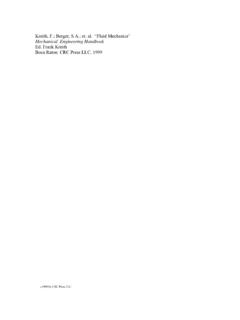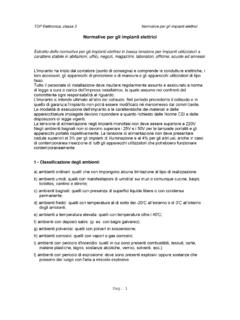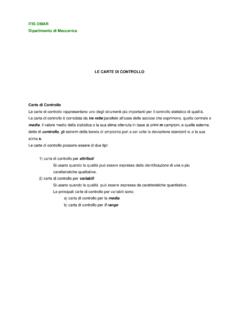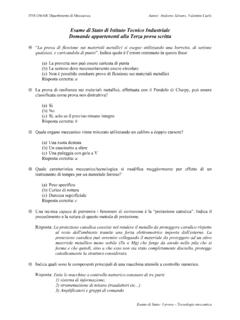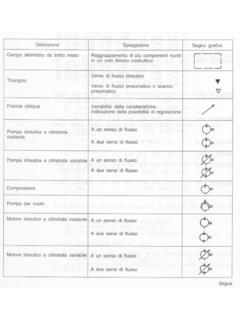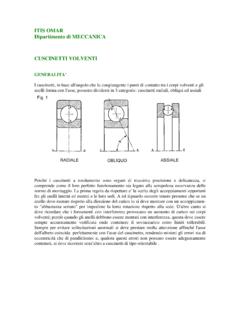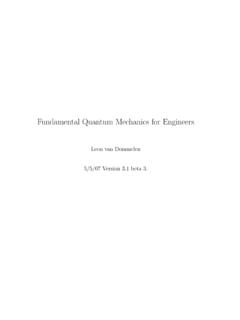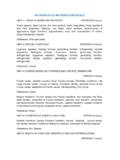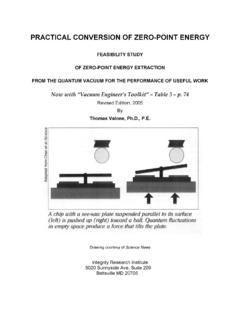Transcription of Moran, M.J. Engineering Thermodynamics …
1 Moran, Engineering Thermodynamics mechanical Engineering HandbookEd. Frank KreithBoca Raton: CRC Press LLC, 1999c 1999byCRCP ressLLC 2 -1 1999 by CRC Press LLC Engineering Thermodynamics 2 Basic Concepts and Definitions The First Law of Thermodynamics , Energy The Second Law of Thermodynamics , Entropy Entropy and Entropy Generation Control Volume Conservation of Mass Control Volume Energy Balance Control Volume Entropy Balance Control Volumes at Steady State Property Relations and Basic Relations for Pure Substances P-v-T Relations Evaluating h , u , and s Fundamental Thermodynamic Functions Thermodynamic Data Retriev al Ideal Gas Model Generalized Charts for Enthalpy, Entropy.
2 And Fugacity Multicomponent Systems Reaction Equations Property Data for Reactive Systems Reaction Equilibrium Exergy Defining Exergy Control Volume Exergy Rate Balance Exergetic Efficiency Exergy Costing Vapor and Gas Power Rankine and Brayton Cycles Otto, Diesel, and Dual Cycles Carnot, Ericsson, and Stirling Cycles Guidelines for Improving Thermodynamic various aspects of what is now known as Thermodynamics have been of interest since antiquity,formal study began only in the early 19th century through consideration of the motive power of heat :the capacity of hot bodies to produce work. Today the scope is larger, dealing generally with energy andentropy , and with relationships among the properties of matter.
3 Moreover, in the past 25 years engineeringthermodynamics has undergone a revolution, both in terms of the presentation of fundamentals and inthe manner that it is applied. In particular, the second law of Thermodynamics has emerged as an effectivetool for Engineering analysis and design. Michael J. Moran Department of mechanical Engineering The Ohio State University 2 -2 Section 2 1999 by CRC Press LLC Fundamentals Classical Thermodynamics is concerned primarily with the macrostructure of matter. It addresses thegross characteristics of large aggregations of molecules and not the behavior of individual microstructure of matter is studied in kinetic theory and statistical mechanics (including quantumthermodynamics).
4 In this chapter, the classical approach to Thermodynamics is featured. Basic Concepts and Definitions Thermodynamics is both a branch of physics and an Engineering science. The scientist is normallyinterested in gaining a fundamental understanding of the physical and chemical behavior of fixed,quiescent quantities of matter and uses the principles of Thermodynamics to relate the properties of are generally interested in studying systems and how they interact with their surroundings. Tofacilitate this, engineers have extended the subject of Thermodynamics to the study of systems throughwhich matter flows. System In a thermodynamic analysis, the system is the subject of the investigation.
5 Normally the system is aspecified quantity of matter and/or a region that can be separated from everything else by a well-definedsurface. The defining surface is known as the control surface or system boundary. The control surfacemay be movable or fixed. Everything external to the system is the surroundings. A system of fixed massis referred to as a control mass or as a closed system. When there is flow of mass through the controlsurface, the system is called a control volume, or open, system. An isolated system is a closed systemthat does not interact in any way with its surroundings. State, Property The condition of a system at any instant of time is called its state. The state at a given instant of timeis described by the properties of the system.
6 A property is any quantity whose numerical value dependson the state but not the history of the system. The value of a property is determined in principle by sometype of physical operation or test. Extensive properties depend on the size or extent of the system. Volume, mass, energy, and entropyare examples of extensive properties. An extensive property is additive in the sense that its value for thewhole system equals the sum of the values for its parts. Intensive properties are independent of the sizeor extent of the system. Pressure and temperature are examples of intensive properties. A mole is a quantity of substance having a mass numerically equal to its molecular weight. Designatingthe molecular weight by M and the number of moles by n, the mass m of the substance is m = n M.
7 Onekilogram mole, designated kmol, of oxygen is kg and one pound mole (lbmol) is lb. Whenan extensive property is reported on a unit mass or a unit mole basis, it is called a specific property. Anoverbar is used to distinguish an extensive property written on a per-mole basis from its value expressedper unit mass. For example, the volume per mole is , whereas the volume per unit mass is v , and thetwo specific volumes are related by = M v . Process, Cycle Two states are identical if, and only if, the properties of the two states are identical. When any propertyof a system changes in value there is a change in state, and the system is said to undergo a process. When a system in a given initial state goes through a sequence of processes and finally returns to itsinitial state, it is said to have undergone a cycle.
8 Phase and Pure Substance The term phase refers to a quantity of matter that is homogeneous throughout in both chemical compo-sition and physical structure. Homogeneity in physical structure means that the matter is all solid, or all liquid , or all vapor (or equivalently all gas). A system can contain one or more phases. For example, avv Engineering Thermodynamics 2 -3 1999 by CRC Press LLC system of liquid water and water vapor (steam) contains two phases. A pure substance is one that isuniform and invariable in chemical composition. A pure substance can exist in more than one phase, butits chemical composition must be the same in each phase. For example, if liquid water and water vaporform a system with two phases, the system can be regarded as a pure substance because each phase hasthe same composition.
9 The nature of phases that coexist in equilibrium is addressed by the phase rule (Section , Multicomponent Systems). Equilibrium Equilibrium means a condition of balance. In Thermodynamics the concept includes not only a balanceof forces, but also a balance of other influences. Each kind of influence refers to a particular aspect ofthermodynamic (complete) equilibrium. Thermal equilibrium refers to an equality of temperature, mechanical equilibrium to an equality of pressure, and phase equilibrium to an equality of chemicalpotentials (Section , Multicomponent Systems). Chemical equilibrium is also established in terms ofchemical potentials (Section , Reaction Equilibrium). For complete equilibrium the several types ofequilibrium must exist determine if a system is in thermodynamic equilibrium, one may think of testing it as follows:isolate the system from its surroundings and watch for changes in its observable properties.
10 If there areno changes, it may be concluded that the system was in equilibrium at the moment it was isolated. Thesystem can be said to be at an equilibrium state. When a system is isolated, it cannot interact with itssurroundings; however, its state can change as a consequence of spontaneous events occurring internallyas its intensive properties, such as temperature and pressure, tend toward uniform values. When all suchchanges cease, the system is in equilibrium. At equilibrium. temperature and pressure are uniformthroughout. If gravity is significant, a pressure variation with height can exist, as in a vertical columnof liquid. Temperature A scale of temperature independent of the thermometric substance is called a thermodynamic temperaturescale.
